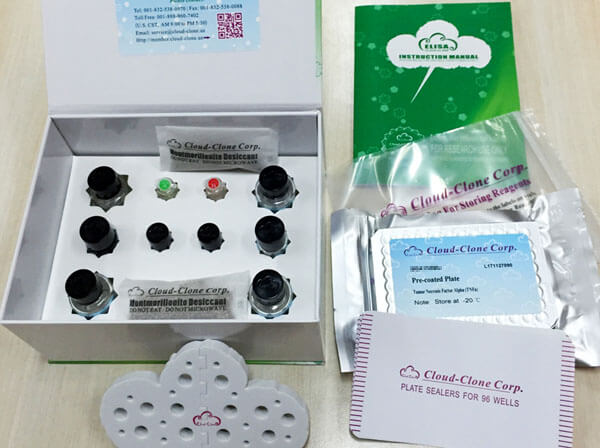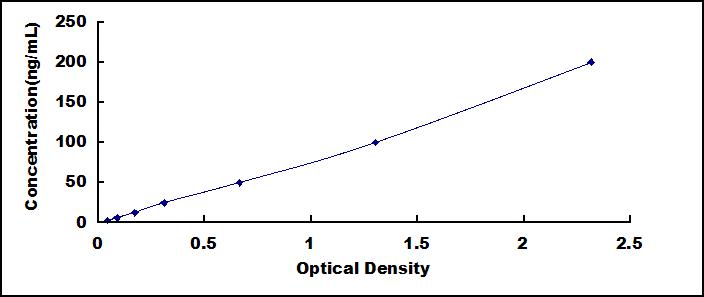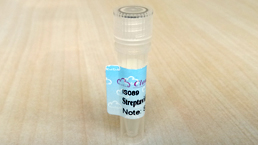ELISA Kit for Heat Shock Protein 70 (HSP70) 

DnaK; 70 Kilodalton Heat Shock Proteins
- UOM
- FOB US$ 441.00 US$ 630.00 US$ 2,835.00 US$ 5,355.00 US$ 44,100.00
- Quantity
Overview
Properties
- Product No.SEA873Hu
- Organism SpeciesHomo sapiens (Human) Same name, Different species.
- ApplicationsEnzyme-linked immunosorbent assay for Antigen Detection.
Research use only - DownloadInstruction Manual
- CategoryTumor immunityInfection immunityDevelopmental science
Sign into your account
Share a new citation as an author
Upload your experimental result
Review

Contact us
Please fill in the blank.
Recovery
Matrices listed below were spiked with certain level of recombinant Heat Shock Protein 70 (HSP70) and the recovery rates were calculated by comparing the measured value to the expected amount of Heat Shock Protein 70 (HSP70) in samples.
| Matrix | Recovery range (%) | Average(%) |
| serum(n=5) | 88-102 | 91 |
| EDTA plasma(n=5) | 93-104 | 99 |
| heparin plasma(n=5) | 99-105 | 102 |
Precision
Intra-assay Precision (Precision within an assay): 3 samples with low, middle and high level Heat Shock Protein 70 (HSP70) were tested 20 times on one plate, respectively.
Inter-assay Precision (Precision between assays): 3 samples with low, middle and high level Heat Shock Protein 70 (HSP70) were tested on 3 different plates, 8 replicates in each plate.
CV(%) = SD/meanX100
Intra-Assay: CV<10%
Inter-Assay: CV<12%
Linearity
The linearity of the kit was assayed by testing samples spiked with appropriate concentration of Heat Shock Protein 70 (HSP70) and their serial dilutions. The results were demonstrated by the percentage of calculated concentration to the expected.
| Sample | 1:2 | 1:4 | 1:8 | 1:16 |
| serum(n=5) | 78-92% | 85-94% | 89-97% | 80-102% |
| EDTA plasma(n=5) | 80-102% | 97-104% | 79-101% | 93-101% |
| heparin plasma(n=5) | 78-102% | 98-105% | 90-101% | 85-103% |
Stability
The stability of kit is determined by the loss rate of activity. The loss rate of this kit is less than 5% within the expiration date under appropriate storage condition.
To minimize extra influence on the performance, operation procedures and lab conditions, especially room temperature, air humidity, incubator temperature should be strictly controlled. It is also strongly suggested that the whole assay is performed by the same operator from the beginning to the end.
Reagents and materials provided
| Reagents | Quantity | Reagents | Quantity |
| Pre-coated, ready to use 96-well strip plate | 1 | Plate sealer for 96 wells | 4 |
| Standard | 2 | Standard Diluent | 1×20mL |
| Detection Reagent A | 1×120µL | Assay Diluent A | 1×12mL |
| Detection Reagent B | 1×120µL | Assay Diluent B | 1×12mL |
| TMB Substrate | 1×9mL | Stop Solution | 1×6mL |
| Wash Buffer (30 × concentrate) | 1×20mL | Instruction manual | 1 |
Assay procedure summary
1. Prepare all reagents, samples and standards;
2. Add 100µL standard or sample to each well. Incubate 1 hours at 37°C;
3. Aspirate and add 100µL prepared Detection Reagent A. Incubate 1 hour at 37°C;
4. Aspirate and wash 3 times;
5. Add 100µL prepared Detection Reagent B. Incubate 30 minutes at 37°C;
6. Aspirate and wash 5 times;
7. Add 90µL Substrate Solution. Incubate 10-20 minutes at 37°C;
8. Add 50µL Stop Solution. Read at 450nm immediately.

Test principle
The test principle applied in this kit is Sandwich enzyme immunoassay. The microtiter plate provided in this kit has been pre-coated with an antibody specific to Heat Shock Protein 70 (HSP70). Standards or samples are then added to the appropriate microtiter plate wells with a biotin-conjugated antibody specific to Heat Shock Protein 70 (HSP70). Next, Avidin conjugated to Horseradish Peroxidase (HRP) is added to each microplate well and incubated. After TMB substrate solution is added, only those wells that contain Heat Shock Protein 70 (HSP70), biotin-conjugated antibody and enzyme-conjugated Avidin will exhibit a change in color. The enzyme-substrate reaction is terminated by the addition of sulphuric acid solution and the color change is measured spectrophotometrically at a wavelength of 450nm ± 10nm. The concentration of Heat Shock Protein 70 (HSP70) in the samples is then determined by comparing the O.D. of the samples to the standard curve.
Giveaways
Increment services
Citations
- Proteomic analysis reveals significant elevation of heat shock protein 70 in patients with chronic heart failure due to arrhythmogenic right ventricular cardiomyopathySpringerLink: b8738j3571287425
- Neuroinflammation in autism spectrum disordersPubMed: PMC3549857
- Luteal serum BDNF and HSP70 levels in women with premenstrual dysphoric disorderPubmed: 23455589
- Concentraciones de proteínas de estrés térmico, L-arginina y dimetilarginina asimétrica en pacientes con síndrome de apnea obstructiva del suePubMed: 26055465
- Heat Shock Proteins,PubMed: 26055465
- The effect of heat stress on gene expression and synthesis of heat‐shock and milk proteins in bovine mammary epithelial cellsPubMed: 26467738
- L-Alanyl-Glutamine Attenuates Oxidative Stress in Liver Transplantation PatientsPubMed: 26518955
- Long-Term Effects of Induced Hypothermia on Local and Systemic Inflammation-Results from a Porcine Long-Term Trauma ModelPubmed:27144532
- Elevated interictal serum HSP-70 levels as an indicator of neurodegeneration for chronic migrainemnstemps:33-1429777310
- STUDY THE RELATIONSHIP BETWEEN SELENIUM AND HEAT SHOCK PROTEINS UNDER HEAT STRESS FOR LOCAL SINAI CHICKENS STRAINabstract:3d115259031
- Physiological consequences for rainbow trout (Oncorhynchus mykiss) of short-term exposure to increased suspended solid loadS0144860916301935
- Prokaryotic expression of chicken interferon-γ fusion protein and its effect on expression ofpoultry heat shock protein 70 under heat stress.pubmed:27753175
- High-dose testosterone enanthate supplementation boosts oxidative stress, but exerts little effect on the antioxidant barrier in sedentary adolescent male rat liver.pubmed:28531762
- SIRT1 inhibits releases of HMGB1 and HSP70 from human umbilical vein endothelial cells caused by IL-6 and the serum from a preeclampsia patient and protects the cells from death.pubmed:28122311
- Concentrations of SP-A and HSP70 are associated with polarization of macrophages in pleural effusions of non-small cell lung cancerpubmed:29111316
- EFFECT OF DIETARY SOURCE OF SELENIUM ON PRODUCTIVE AND REPRODUCTIVE PERFORMANCE OF SINAI LAYING HENS UNDER HEAT STRESS CONDITIONS.125788660
- SIRT1 inhibits releases of HMGB1 and HSP70 from human umbilical vein endothelial cells caused by IL-6 and the serum from a preeclampsia patient and protects the cells from deathDOI:10.1016/j.biopha.2017.01.087
- IMPACT OF CHROMIUM PICOLINATE SUPPLEMENTATION ON PRODUCTIVE PERFORMANCE, IMMUNE RESPONSE AND HEAT SHOCK PROTEINS OF BROILER CHICKENS UNDER HEAT-STRESS CONDITION.ISSN: 1110-5623
- Physiological consequences of chronic exposure of rainbow trout (Oncorhynchus mykiss) to suspended solid load in recirculating aquaculture systems10.1016/j.aquaculture.2017.11.030
- Detection of 70 kDa heat shock protein in the saliva of dairy cows.pubmed:28625184
- Reducing rumen starch fermentation of wheat with three percent sodium hydroxide has the potential to ameliorate the effect of heat stress in grain-fed wetherspubmed:29293755
- Ectopic expression of Miro 1 ameliorates seizures and inhibits hippocampal neurodegeneration in a mouse model of pilocarpine epilepsyPubmed:29365285
- THE EFFECT OF CHROMIUM PICOLINATE SUPPLEMENTATION ON IMMUNE RESPONSE AND HEAT SHOCK PROTEINS OF LAYING HENS UNDER HEAT …article_5570_5c06907ac09a7724a58d2b796fe91aba.pdf
- EFFECT OF MITIGATION OF HEAT STRESS BY EARLY HEATE ACCLIMATION AND GLUTAMINE INJECTION ON SOME PHYSIOLOGICAL MEASUREMENTS …:
- Signature-oriented investigation of the efficacy of multicomponent drugs against heart failurePubmed: 30230922
- Maged Mohamed Abd-Elhakim Barakat, Noha Ahmed El-Boghdady, Ebtehal Kamal Eldin Farrag, Ataa Abdelhalim Said and Sylvia Edward Shaker
- Effective Visualization and Easy Tracking of Extracellular Vesicles in Glioma Cells
- Protective and Curative Effects of Bombax ceiba Flower and Ziziphus spina christi Fruit Extracts on Gastric Ulcer
- PHYSIOLOGICAL ADAPTATIONS TO HEAT ACCLIMATION; REPERCUSSIONS ON CYCLING PERFORMANCE
- Possible prophylactic effect of omega-3 fatty acids on cadmium-induced neurotoxicity in rats' brainsPubmed: 31468353
- Oxidative stress mediated apoptotic potential of mefloquine on experimental trichinellosisPubmed: 33221280
- Pathophysiological Changes in Female Rats with Estrous Cycle Disorder Induced by Long-Term Heat StressPubmed: 32685488
- EFFECTS OF HEAT STRESS ON PHYSIOLOGICAL PARAMETERS AND SERUM CONCENTRATION OF HSP70 IN INDIGENOUS BREEDS OF SHEEP IN NIGERIA
- Effect of organic acid blend and prebiotic on growth performance gut histomorphometry, tibia bone characteristics, reactive oxygen species, microbial count and …
- Concurrent high-intensity aerobic and resistance exercise modulates systemic release of alarmins (HMGB1, S100A8/A9, HSP70) and inflammatory …
- Physiological impacts of suspended solids in recirculating aquaculture
- Evaluation of heat shock protein 70 and toll-like receptor 4 expression in gingival crevicular fluid in response to orthodontic forces34091792
- Effects of L-proline on cellular responses of hen erythrocytes subjected to thermal stress33627283
- The Restorative Effect of Gallic Acid on the Experimental Sciatic Nerve Damage Model34376039
- Neuroprotective effect of sodium alginate against chromium-induced brain damage in ratsPubmed:35421180
- Identification of marker proteins in preterm and term birth: Relationship of rankl and HSP70 in the cord blood















